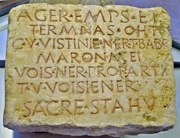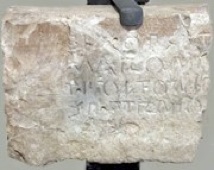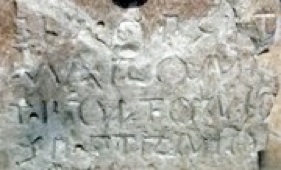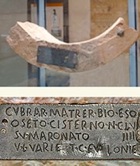Meddix: City Walls of Asisium (ca. 250 BC)
Writing in the late 1st century BC, the poet Sextus Propertius remembered “ancient Umbria”, where he had been born, and
-
“... the wall towers from the summit of climbing Asisium, that wall made more famous by your genius” (‘Elegies’, 4)
These walls (of which large sections survive) ran for some 2.5 km and enclosed some 60 hectares, which indicates that Asisium was only slightly smaller in area that nearby Perusia (Perugia) and was bigger than most other Umbrian cities at this time. In the catalogue “Scehrto Est’ (referenced below), Alberto Calderini (at p. 46) pointed out that these walls can be roughly dated by two surviving Umbrian inscriptions, which he placed in the middle of the 3rd century BC:
-
✴The first (ST UM 5, described in Entry 31, by Alberto Calderini and Giulio Giannechini), of which only the right part survives, was from the architrave of a gate in these walls that was discovered in 1938 near the ex-Oratorio di San Lorenzo: the architrave is still preserved in the garden of what became the Berkeley Villa. It contains a fragmentary Umbrian inscription that uses an Etruscan alphabet, which has been transcribed:
-
estac vera vaper[ia?]...
-
mestiça vipies ep...
-
The first line seems to confirm that the stone was part of a stone gate (‘vera vaperia’), while the second seems to mean “under the meddix Vibius Ep…”.
-
✴The second (described in Entry 32, by Giulio Giannechini) was discovered near the Abbazia di San Pietro in 1742 but no longer survives. Surviving records suggest that this inscription also recorded the construction of a gate by the meddix Vibius.
The word “meddix” described a magistrate: Alberto Calderini (as above) suggested that the magistrates named in these inscriptions from Assisi might have been the same person or, more probably, two people from the same family.
This is the only known appearance of this magistracy in an Umbrian inscription, but it is more frequently recorded in the Oscan-speaking communities to the south of modern Umbria, where it seems to designate a supreme magistrate. Simone Sisani (referenced below, 2007, at p. 252) pointed out that these records at Asisium are some decades older than all the other known Umbrian records of magistracies. He suggested two possibilities for the significance of the meddix at Asisium in the 3rd century BC:
-
✴it represented an early phase in the development of the administrative structures employed in the region; and/ or
-
✴ it was a quasi-religious position associated with the sacred rites used during the establishment of inviolable boundaries.
Uhteres and Marones
According to Simone Sisani (referenced below, 2007, at p. 249) after the Roman conquest:
-
“The administrative structure of [the Umbrian communities that enjoyed independence under Roman hegemony] appears to have been based on a college formed by two pairs of magistrates: the auctores [or uhteres]; and the marones. [The auctores seem to have been ] the leading magistrates within the college. ... the marones seem to have been of an inferior status, with a function associated with ... public works” ” (my translation).
The term marone seems to be related to “maru”, which is a term for some form of magistrate found on a number of Etruscan inscriptions.
In the section headings below, the numbers in square brackets refer to the catalogue entry in “Scehrto Est’ (referenced below).
Uhteres and Marones
Asisium: Cippus from Bastia (120 - 90 BC) [45]
This relatively late cippus contains the only known example of an inscription (ST Um 10, CIL XI 5389) that identifies all four magistrates of an administrative college (which we know from the presence of Nero Babrius was the administrative college of Asisium - see below). It was found in 1742 at Ospedalicchio, near Bastia (between Assisi and Perugia) and is now in the Museo Archeologico Nazionale, Perugia. (There is a plaster cast of it in the Museo Civico, Assisi).
The inscription, which is one of the longest surviving inscriptions in the Umbrian language (after the Iguvine Tables), uses the Latin alphabet. It reads:
TERMNAS OHT[RETIE]
C V VISTINE NER T BABR[IE]
MARONATEI
VOIS NER PROPARTIE
T V VOISNIER
SACRE STAHU
The inscription refers to a field (ager) that has been bought and delimited (emps et termnas) during the period of office of:
-
✴the two men who held the post of uhter in the year in question:
-
•C(aius) Vestinius, son of V(ibius) and
-
•Ner(o) Babrius, son of T(itus); and
-
✴the two men who held the post of marone:
-
•Vois(ienus) Propartius, son of Ner(o); and
-
•T(itus) Voisienus, son of V(ibius).
Nero Babrius, son of Titus appears in the more junior post of marone in the (presumably earlier) Latin inscription on the cistern at San Rufino, Assisi (below).
The final words “sacre stahu” probably imply that the field had religious significance. It is suggestive that the spelt used in the annual ritual described in Table Vb of the Iguvine Tables came from two specified fields:the Ager Tltius and the Ager Casilus of Picus Martius. Simoni Sisani (referenced below, 2012, p. 422) has suggested that the ager near Bastia might well have been bought and delimited by the magistrates of Asisium for a similar purpose.
Uhteres
Mevania: Sarcophagus Cover (2nd century BC) [50]
This fragment of a sarcophagus, which came from the area of Bevagna and which is is now in the Museo Civico, Gubbio, is decorated with a relief of a wheel flanked by griffins. The inscription (ST Um 25) below uses an Etruscan alphabet:
Pe. Pe. Uferier Uhtur
It commemorates Petro Ofedius, son of Petro, who held the post of uhter.
Gubbio: Iguvine Tables (3rd - 1st centuries BC)
Table Va of the Iguvine Tables from Gubbio seems to be a list of decrees emanating from two meetings of the brotherhood, which were dated by reference to the year of the “uhteretie” (magistracy) of:
-
✴“t t kastruciie” (Titus Castricius, son of Titus); and then
-
✴“k t kluviier” (Caius Cluvius, son of Titus).
This use as a dating device suggests that the uhter was a magistrate of Ikuvina rather than an official of the Atiedian Brotherhood (whose rituals were described in the tables). The fact that only one such magistrate was used to date each meeting suggests (at least to me) that: either the formula referred only to the senior of the two uhteres: or, at Iguvina, the magisterial college contained only one uhter. (A uhter was also present at some of the rituals that the tables describe.)
Marones
Fulginia (?): San Pietro di Flamignano (220 - 200 BC) [33]
Detail
According to Chiara Lorenzini (referenced below, at p. 32), this inscription (ST UM 6, EDR 162789), which is is now in the Museo Archeologico, Palazzo Trinci, Foligno, was:
-
“... found in 1928 in a field at Colle San Pietro, between Trevi and Sant’ Eraclio, in the locality of San Pietro in Flamignano, along [the eastern branch of] Via Flaminia, about 2 km from a fountain known locally as ‘Petruio’” (my translation).
The text, which is in the Umbrian language and uses the Latin alphabet, reads:
bia . opset
marone/ t . foltonio/ se . ptrnio
The first line relates to the construction of something described as a ‘bia’ (probably a fountain) while the final two lines record the names of two marones: T(itus) Foltonius; and Se(xtus) Petronius. This suggests that these ‘marones’ had commissioned the ‘bia’, although it is alternatively possible that their names were recorded merely as a dating device.
According to Simone Sisani (referenced below, 2007, pp. 381-2):
-
“[On the basis of paleographic analysis,] it is difficult to countenance a date later than [ca. 200 BC for this inscription]: a “terminus circa quem” (approximate date) is furnished by the opening of Via Flaminia [in 220 BC], with which the building project mentioned in the inscription could have been connected” (my translation).
He attributed (at p. 142) the early use of the Latin alphabet in the inscription to the ‘Romanising’ effect of the opening of Via Flaminia. He further noted (also at p. 142) that the find spot was immediately south of Fulginia and reasonably assumed that the marones named in the inscription had held office there.
Simone Sisani (referenced below, 2007, p. 142) argued that:
-
“The use of the Umbrian language [in the inscription ] and, above all, the [implied] ‘local’ nature of its administration, make it certain that Fulginia was still an autonomous centre [at this time]” (my translation).
On this model, Fulginia was incorporated into the Roman state as a prefecture with a properly “Roman” magistracy at some time after ca. 220 BC. However, not all scholars agree with this: for example, Ronald Syme (referenced below, at p. 295) assumed that Fulginia was already a prefecture at the time of the inscription but:
-
“... although the Romans [had] deprived Fulginia of its independence ..., they [had not bothered] to interfere with its traditional institutions, but [rather] allowed the marones to [continue in office], no doubt with lessened competence.”
Helvillum (Tadinum ?): Bronze Plaque (2nd century BC) [35]
This inscribed bronze plaque in in the
Museo Archeologico Nazionale, Perugia was found in 1868 at Aja della Croce, near Fossato di Vico, the site of Helvillum Vicus. The inscription (ST UM 7), which uses the Latin alphabet, reads:
CVBRAR MATRER BIO ESO
OSETO CISTERNO N(ummi) CLV
IIII SV MARONATO
V L VARIE T C FVLONIE
Simone Sisani (referenced below, 2007, at p. 400, entry 96) dated it to the late 3rd century BC, but Giulio Giannecchini (in L. Agostiniani et al., referenced below, p. 51, entry 35) more recently dated it to the second half of the 2nd century BC.
Simone Sisani (referenced below, 2009, pp. 204-5, entry 26) observed that the inscription conveys two distinct pieces of information:
-
✴the first line can be translated as:
-
“this [is] the ‘bia’ [probably a fountain] of [the goddess] Cupra Mater”; and
-
✴the last three lines record that:
-
“[this] cistern was built at a cost of 159 nummi in the maronate (magistracy) of
-
•Vibius Varius, son of Lucius; and
-
•Titus Fullonius, son of Gaius.
Sisani suggested that:
-
✴the terracotta support to which the plaque is still fixed probably came from the rim of a round puteal that covered the opening of the cistern through which water was draw; and
-
✴the cistern was used to store water that had taken from the fountain of Cupra Mater, which was therefore sacred to the goddess.
In an earlier publication, Simoni Sisani (referenced below, 2007, at p. 400) reasonably suggested that the marones named in it been magistrates of nearby Tadinum, to which Helvillum had almost certainly belonged (as discussed above).
Assisi: San Rufino (140-100 BC)
Plaster cast of CIL XI 5390 in the Museo Civico, Assisi
The original survives in situ in the campanile of San Rufino
This inscription (CIL XI 5390), which remains in situ over an arch that leads to a Roman cistern that now forms the foundation for the campanile of San Rufino, is one of the earliest in Latin to survive in an Umbrian city: the EAGLE database (see the CIL link) dates it to the period of the last 4 decades of the 2nd century BC. The inscription, which is one of the earliest in Latin to survive in an Umbrian city, names six marones (magistrates), presumably as a dating device for a period of three years:
-
✴Post(umus) Mimesius, son of C(aius);
-
✴T(itus) Mimesius, son of Sert(orius);
-
✴Ner(o) Capidas Rufus, son of C(aius);
-
✴Ner(o) Babrius, son of T(itus);
-
✴C(aius) Capidas, son of T(itus), grandson of C(aius); and
-
✴V(ibius) Volsienus, son of T(itus).
The main part of the inscription reads:
murum ab fornice ad circum et fornicem cisternamq(ue)
d(e) s(entaus) s(ententia) faciundum coiravere
This records the building, by order of the municipal senate, of cistern itself and a terrace wall that apparently extended from the arch of the cistern to another arch near the circus (which was in modern Piazza Matteotti).
Nero Babrius, son of Titus had the more senior post of uhter in the Umbrian inscription on the cippus from Bastia (above), which is therefore probably of a slightly later date. It is interesting to note that both the Latin and Umbrian languages were used in public inscriptions in the late 2nd and early 1st centuries BC.
Bevagna: A Late Marone
A (now lost) fragmentary inscription (AE 1965, 279a), which was discovered in 1958 on a stone that was embedded near the font of San Bartolomeo, Montefalco, commemorated a man whose name is missing from the top of the stone. The surviving part of the inscription reads:
]Q VI VIR SAC[R?][...
]AEST MARONI I[...
[M]UNICIP(ES) ET INC[OLAE]
This recorded:
-
✴the subject’s tenure in two positions in a municipal magistracy, presumably that of Mevania (Bevagna):
-
•quattuorvir quinquennial (completed from “]Q” in the first line); and
-
•quaestor (completed from “]AEST” in the second line;
-
✴his probable role as a sevir sacris faciundis (completed from “VI VIR SAC[R?][...” in the first line (discussed below); and
-
✴his position as a ‘marone’ (discussed below).
The last line of the inscription presumably referred to the inhabitants of Mevania, including foreign residents (incolae). It is likely that:
-
✴they had dedicated something to the illustrious man named in the dedication; or
-
✴he had undertaken a public commission for their benefit.
Elena Roscini (in L. Agostiniani et al., referenced below, entry 78, pp. 86-7) dated this inscription to the early Augustan period (i.e. to the early part of 27 BC - 14 AD).
The completion of “VI VIR SAC[R?][...” in the first line as sevir sacris faciundis is not completely secure, although this priesthood is known in Mevania from other inscriptions. Laura Bonomi Ponsi (in A. Feruglio et al., referenced below, pp. 85-6; entry 2:121) pointed out that, in this inscription, only the upright of the letter assumed to be “R” survives. The completions could alternatively be ”SACE(rdote)”, in which case the subject would have held the separate posts of sacerdote (priest) and sevir (member of a college of six).
The presence in the cursus of the post of ‘marone’ is unexpected in the period after municipalisation: Simone Sisani (referenced below, 2007, at p. 254) proposed that the post of ‘marone’ in AE 1965, 279a represented an:
-
“... antiquarian recuperation, of a cult nature” (my translation).
Read more:
R. Syme (the author, who died in 1989) and F. Santangelo (who edited these papers from the Ronald Syme archive), “Approaching the Roman Revolution: Papers on Republican History”, (2016) Oxford
S. Sisani, “I Rapporti tra Mevania e Hispellum nel Quadro del Paesaggio Sacro della Valle Umbra”,, in
G. Della Fina (Ed.), “Il Fanum Voltumnae e i Santuari Comunitari dell’ Italia Antica”, (2012) Orvieto (pp. 409-64)
S. Sisani, “Vmbrorvm Gens Antiqvissima Italiae. Studi sulla Società e le Istituzioni dell' Umbria Preromana.”, (2009)Perugiae
L. Agostiniani et al. (Eds), “Screhto Est: Lingua e Scrittura degli Antichi Umbri”, (2011) Città di Castello
S. Sisani, “Fenomenologia della Conquista: La Romanizzazione dell' Umbria tra il IV sec. a. C. e la Guerra Sociale”, (2007) Rome
C. Lorenzini, “Iscrizione dei Marones da San Pietro in Flamignano”, in:
“Fulginates e Plestini: Popolazioni Antiche nel Territorio di Foligno: Mostra Archeologica”, (1999) Foligno
Umbria before the Social Wars: Main page
Umbrian Magistracies Via Amerina Via Flaminia Second Punic War
Umbrian Inscriptions Etruscan Inscriptions Latin Inscriptions
Literary Sources
Return to the History Index









